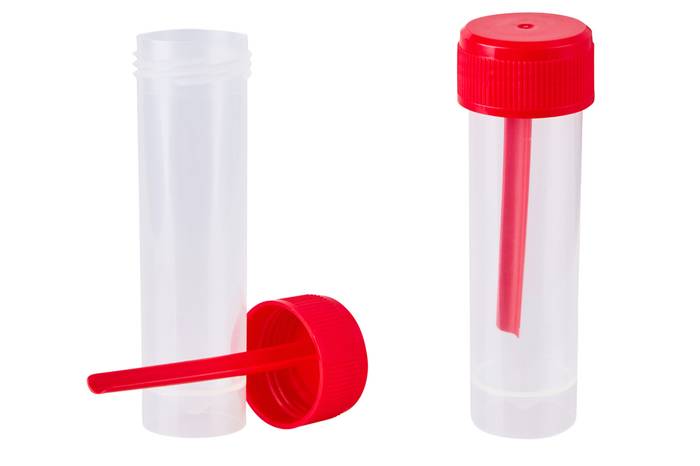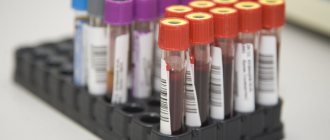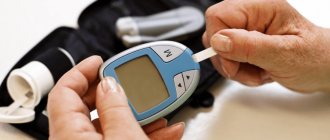A fecal occult blood test is a laboratory diagnostic method that can detect the presence of blood in stool that is invisible to the naked eye or under a microscope. If after defecation a person notices an admixture of brown-red color, or, on the contrary, a too dark shade of the stool, then this is a reason to sound the alarm. Blood in the stool is the “first sign” of colon and rectal cancer. These symptoms can be harbingers of more than one dangerous disease. However, often the color of stool does not visually change, so screening methods have been developed to identify pathology, for example, medical examination.
Most of the diseases occur in a latent form and most often simply do not bother a person. But at the same time, there are already grains of blood in the stool. They can only be detected through laboratory testing. Fecal occult blood testing is considered one of the most common today. It is prescribed to the patient in order to identify hidden bleeding that is located in the organs of the gastrointestinal tract.
Preparation for collecting material for analysis
Content:
- Preparation for collecting material for analysis
- Indications for the study
- Analysis results
- Conclusion
In order for the outcome of the study to be as accurate as possible, it is necessary to follow a number of simple instructions; this will help to avoid incorrect results.
Among the most basic requirements before collecting material, nutrition comes first.
One should be light and low in calories for the stomach. It is necessary to exclude meat, seafood, offal, tomatoes, apples, spinach, and sweet peppers from your menu 3-4 days before the procedure. In addition, you should stop taking products that have a laxative effect, vitamins and dietary supplements with iron.
Approximately 10 days before the test, you need to stop taking medications that affect the gastrointestinal tract or can color the stool a different color. You should not take an x-ray a few days before the test.
On the day of the procedure, doctors advise not to brush your teeth. If the gums are damaged during cleaning, small particles of blood enter the intestines and cause distortion of the tests. It is also a good idea to prepare special containers for feces. Doctors insist that the patient collect several fragments, namely 5, from the entire stool into a container.
If a woman has her menstrual period, it would be reasonable to postpone the study until it is completely over so that menstrual blood does not get into the stool. The collected material must be transferred to the laboratory for further diagnosis of the material within 1 to 3 hours after defecation.
Why is an occult blood test needed?
If you suspect intestinal problems during diagnosis, it is possible to get by with a little blood. Moreover, in the literal sense, you just need to do the appropriate laboratory test. Fecal occult blood testing has been widely used in medicine for more than half a century, as it is a convenient and simple way to detect invisible blood loss to the intestines. Studies have shown that mortality from colon cancer, for example, can be reduced by 30% just through annual testing.
But this test has limitations - before taking it, you need to observe a special rule for 3-4 days, excluding lightly cooked meat and uncooked smoked sausages, since the test system can “see” animal hemoglobin in the stool sample and give a so-called “false positive” result.
Start simple
The presence of clearly noticeable blood in the stool does not necessarily mean something terrible. Most often, it indicates banal hemorrhoids or anal fissure. But you can’t ignore the symptom, because, in particular, this is how colorectal cancer can manifest itself. True, blood in the feces is usually not visible with this disease, since it is secreted in small quantities and, moreover, in the higher parts of the intestine. Therefore, as a rule, it cannot be detected with the naked eye. And even during microscopic examination it is often not visible. Therefore, it can only be found in the laboratory. A sensitive and specific test for transferrin and hemoglobin in stool is now widely used. The study of feces for occult blood is based on the determination of the proteins human hemoglobin and transferrin in this biomaterial. And if hidden blood is detected in the stool, it is advisable to do a colonoscopy with this test.
Stop panicking!
You should not panic if you receive a positive result from such a test. A positive test result is a reason for additional examination. In addition to colon and rectal cancer, there may be other reasons for the appearance of blood in the stool: also peptic ulcer of the stomach and duodenum, ulcerative colitis, erosive esophagitis, parasitic infection and others.
The significance of the study increases if it is done not sporadically, but regularly - once a year. This annual analysis is especially important for patients over 40 years of age.
Preparation is serious business
Anal fissure or hemorrhoids can cause fresh blood in the stool that is visible to the naked eye. Fresh blood may not give a positive result in this test. The test system is configured in such a way that it reacts not to the presence of red blood cells, but to proteins that fall out of blood cells during the breakdown of hemoglobin. This is what gives us the opportunity to see already changed blood, and not fresh blood, which is visible anyway. The test allows you to suspect the presence of a source of bleeding throughout the gastrointestinal tract.
But the main thing is that the stool must be collected naturally, without the use of laxatives (no matter which ones - in the form of drugs or enemas). Another essential requirement is to prevent urine and water from getting into the collected stool. If X-ray diagnostics of the gastrointestinal tract was carried out, then the analysis can be carried out only after 2-3 days. And after conducting instrumental studies of the gastrointestinal tract, you need to wait two weeks.
As for following a special diet before taking the test, today there is no such need. The test is carried out using a high-precision immunochromatographic method using specific bodies for hemoglobin and transferrin, so no dietary restrictions need to be observed.
Indications for the study

A test to detect occult blood in the stool is a classic test that will allow you to diagnose cancer. Most often it is prescribed in case of patient complaints about:
- abdominal pain;
- prolonged nausea, vomiting and heartburn;
- loose stools;
- sudden weight loss, etc.
If the doctor has decided to prescribe this study, then you should not back down. This analysis is absolutely harmless and does not cause any harm to the human body.
Why is analysis needed and what does it give?
| During an annual medical examination, persons over 40 years of age are recommended to undergo a fecal occult blood test. The analysis reveals gastrointestinal pathologies in the early stages, which makes it possible to use it as a screening method. Any inflammation, polyp or tumor of the intestine is accompanied by bleeding, but the amount of blood is so small that it cannot be determined visually. However, this amount is sufficient to determine blood contamination using a laboratory method. |
|
There are two methods for determining occult blood in stool:
- benzidine (guaiac test)
- shows an admixture of any hemoglobin in the stool. Therefore, the method gives a number of errors in the absence of preparation in the form of a special diet three days before the test;
- immunochemical method
is the most accurate. It shows the presence of human hemoglobin, and not what comes from food. The method does not require special preparation. The disadvantage of the immunochemical method is the long readiness period, about 14 days.
Analysis results
It is considered normal if a negative result is obtained. This indicates that there is no bleeding in the gastrointestinal tract. If the result is positive, the analysis shows the possible presence of the following problems:
- stomach and duodenal ulcers;
- Crohn's disease;
- damage to the upper intestines;
- ulcerative colitis;
- polyps of the digestive organs;
- helminths;
- haemorrhoids;
- fissures in the anus;
- intestinal tuberculosis;
- varicose veins of the esophagus, etc.
But you shouldn’t ring all the bells at once. Sometimes it happens that the test result turns out to be false positive or false negative.
The first option is possible in case of injury to the mouth or tongue. For example, a patient damaged his mucous membranes with food, and thus blood particles entered the stomach. If the symptoms do not disappear, the doctor will order the test again.
In the case of the second option, blood in the stool may not be a constant phenomenon, but a rare one that occurs from time to time. The reason for this may be polyps.
What is occult blood
Occult blood does not affect the color of stool and is not detected microscopically or macroscopically. According to medical data, about 2 milliliters of blood are released in the stool every day, namely 2 milligrams of hemoglobin per 1 gram of feces. Determination of occult blood will help identify proctological and gastroenterological pathologies such as:
- diverticulitis;
- intestinal tuberculosis;
- ulcerative damage to the mucous membrane;
- benign and malignant neoplasms;
- nonspecific ulcerative colitis;
- Crohn's disease;
- intestinal infection;
- necrotizing enterocolitis;
During gastrointestinal bleeding, unchanged hemoglobin or a structure in which minimal changes have occurred is formed in the stool. The intensity of hemoglobin destruction depends on the location and severity of bleeding, on the neglect of the pathology, and on the presence of complications. As is known, hemoglobin is an unstable analyte.
Stable compounds include transferrin, which detects internal bleeding in the upper intestines. Blood protein enters the intestinal lumen during advanced pathologies of the gastrointestinal tract, with significant damage to the mucous membrane.
Rules for collecting biomaterial
In order to obtain reliable results, it is necessary to correctly collect the biomaterial.
- After emptying the bladder, hygienic washing of the external genitalia and anal area is carried out using neutral (without fragrances) soap;
- After defecation, feces are collected in a special container with a lid. The volume of biomaterial required for research is 40 g. A prerequisite is that samples must be taken from different areas of feces (3-4 points);
- After collection, the container with stool is sent to the laboratory for examination. Until dispatch, it is allowed to store the biomaterial in the refrigerator at a temperature of 4-6C, but not more than 8 hours.

Remember!
Collection of stool for testing for occult blood is not carried out during and 3-5 days after the end of menstruation, as well as during exacerbation of hemorrhoids.
Other stool tests
- Coprogram
- Feces for occult blood
- Pancreatic elastase
- Carbohydrates in feces
Indications for use
A fecal occult blood test is mandatory for older people over the age of sixty. Age-related changes directly affect intestinal function, so age is a direct indication. Laboratory research is carried out in the differential diagnosis of anemia, when helminths are detected, to assess damage to the mucous membrane of the gastrointestinal tract.
Intestinal pathologies are diagnosed, such as polyposis, diverticulitis, ulcerative colitis, necrotizing enterocolitis at an early age. The patient's condition is assessed during the treatment of peptic ulcer, Crohn's disease, and intestinal tuberculosis.
Analysis of feces for occult blood helps to detect in time:
- primary and metastatic tumors of the gastrointestinal tract;
- ulcerative damage to the gastrointestinal mucosa;
- helminthiases with damage to the intestinal mucosa;
- infectious intestinal lesions;
This diagnostic technique is more sensitive than less specific methods, such as benzidine and guaiac tests. The amount of hemoglobin and transferrin in stool is determined by immunochromatographic method. A fecal occult blood test determines a violation of the integrity of the mucous membrane and the presence of a duodenal papilla. The degree of soft tissue damage and the effectiveness of treatment are assessed.
The procedure is prescribed for chronic constipation and diarrhea, heartburn, nausea and vomiting, and acute pain in the intestines. Indications include mushy stool, false urge to defecate, rapid weight loss or causeless obesity, and elevated body temperature.
If a benign or malignant neoplasm has been identified, instrumental and laboratory diagnostic methods are carried out regularly to monitor the patient’s condition.
Interpretation
The reasons for a positive test result may be: 1. The presence of colorectal bleeding (oncological process in the colon or rectum, polyps, inflammatory bowel diseases, diverticulosis, hemorrhoids); 2. Use of medications that affect blood clotting; 3. Damage to the mucous membrane as a result of medical procedures (colonoscopy, enemas). A negative test result for hemoglobin in the stool virtually eliminates the presence of colorectal bleeding.
Interpretation of results
The norm for testing stool for occult blood is its absence, i.e. negative result.
A positive reaction is assessed in “points” from 1 to 4: “+”, “++”, “+++”, “++++” and suggests the presence of pathologies:
- hemorrhoids (inflammation of the hemorrhoidal veins)
- peptic ulcer;
- nonspecific ulcerative colitis;
- helminthiasis and other parasitic diseases;
- erosive esophagitis;
- intestinal tuberculosis (infectious disease caused by mycobacteria);
- dilation of the veins of the esophagus with thrombophlebitis of the splenic vein (inflammation of the vascular walls with the formation of a blood clot that blocks the lumen of the vein);
- dilation of the veins of the esophagus with cirrhosis of the liver (changes in the structure of the liver tissue);
- primary and metastatic neoplasms of the gastrointestinal tract;
- colorectal cancer (tumor of the colon mucosa);
- Rendu-Osler disease (a hereditary disease characterized by the appearance of pathological bleeding formations (angiomas, telangiectasia) on the mucous membranes of the gastrointestinal tract);
Factors of influence
- Failure to comply with the prescribed diet and other medical recommendations;
- Colon polyps (false negative result in 20% of cases);
- Colorectal cancer (false negative result in 20% of cases);
- Other heavy internal bleeding (nose, gum, menstrual, etc.).
A fecal occult blood test demonstrates high reliability when repeated. But negative results do not exclude the presence of tumor, ulcerative or erosive processes in the patient. Therefore, making an accurate diagnosis must take into account other instrumental and laboratory studies.
The analysis is interpreted by a gastroenterologist, oncologist, surgeon, therapist, pediatrician, and general practitioner.







